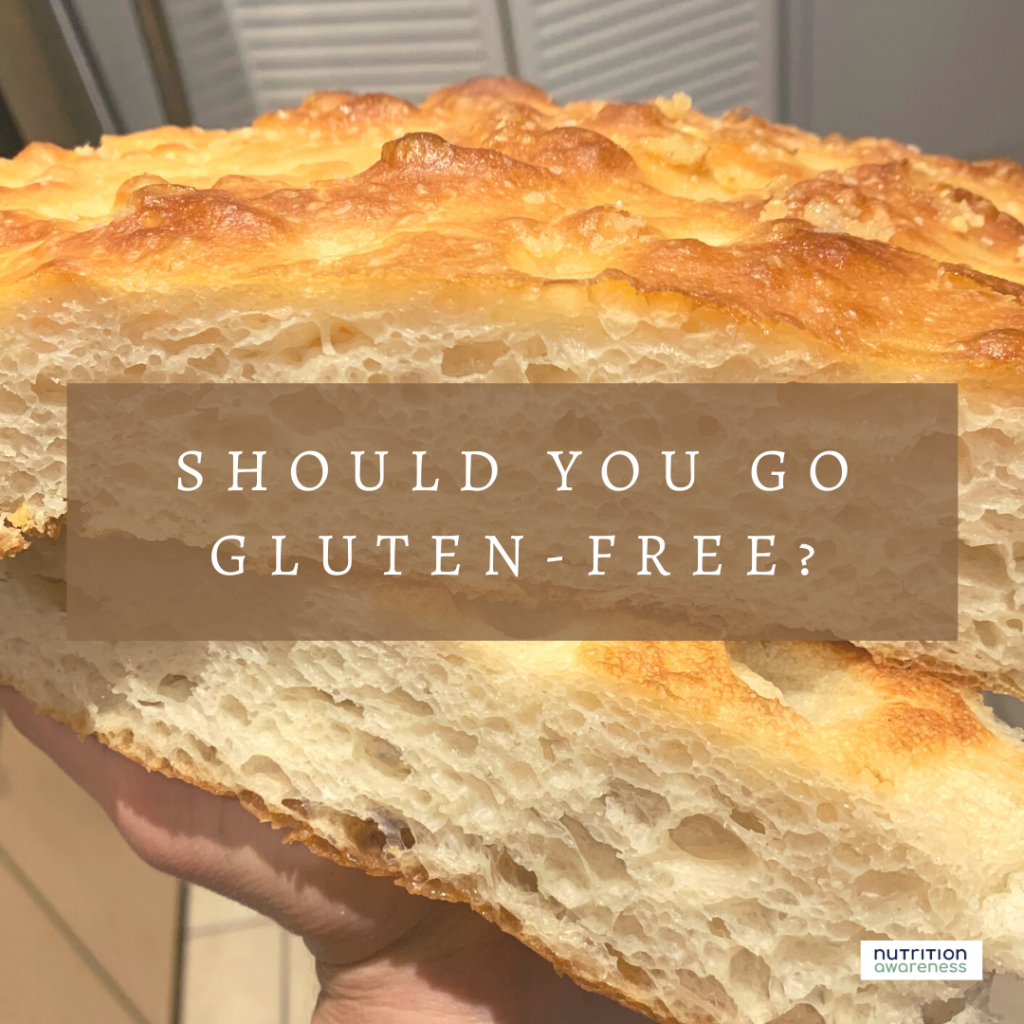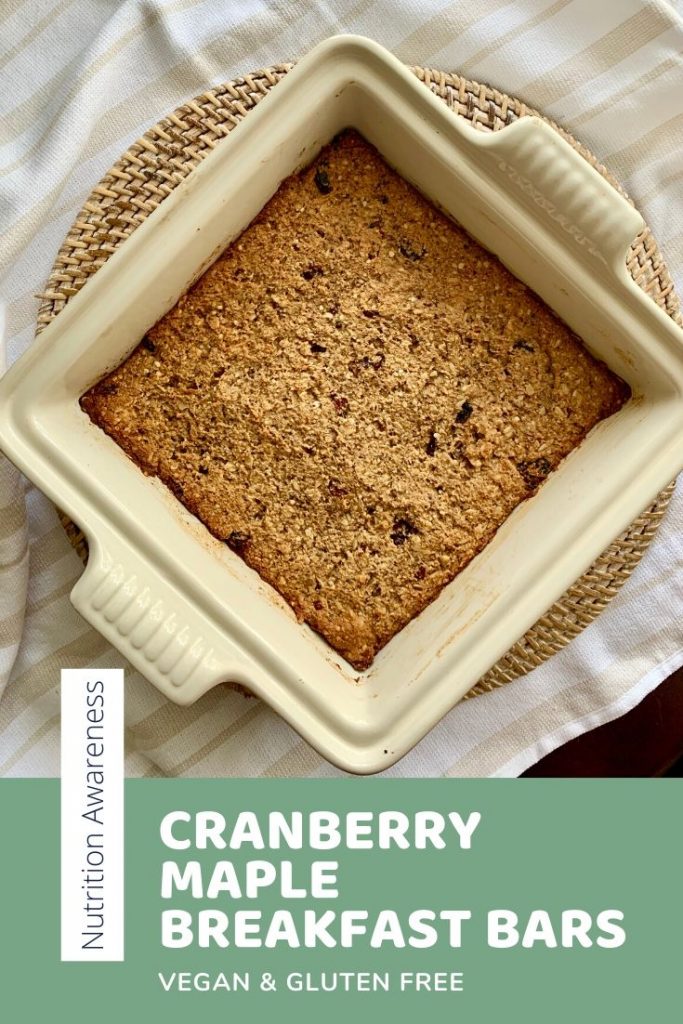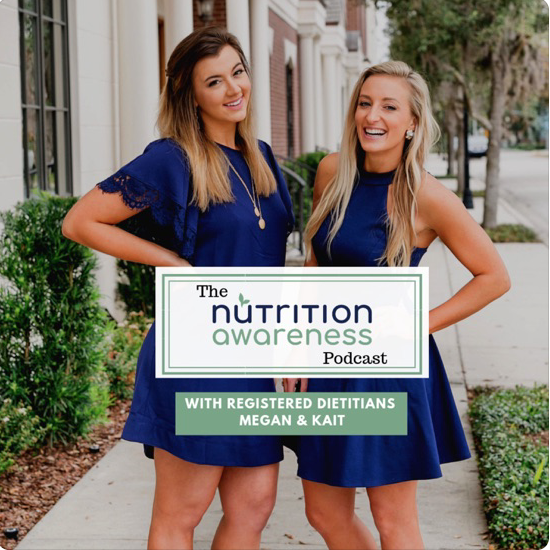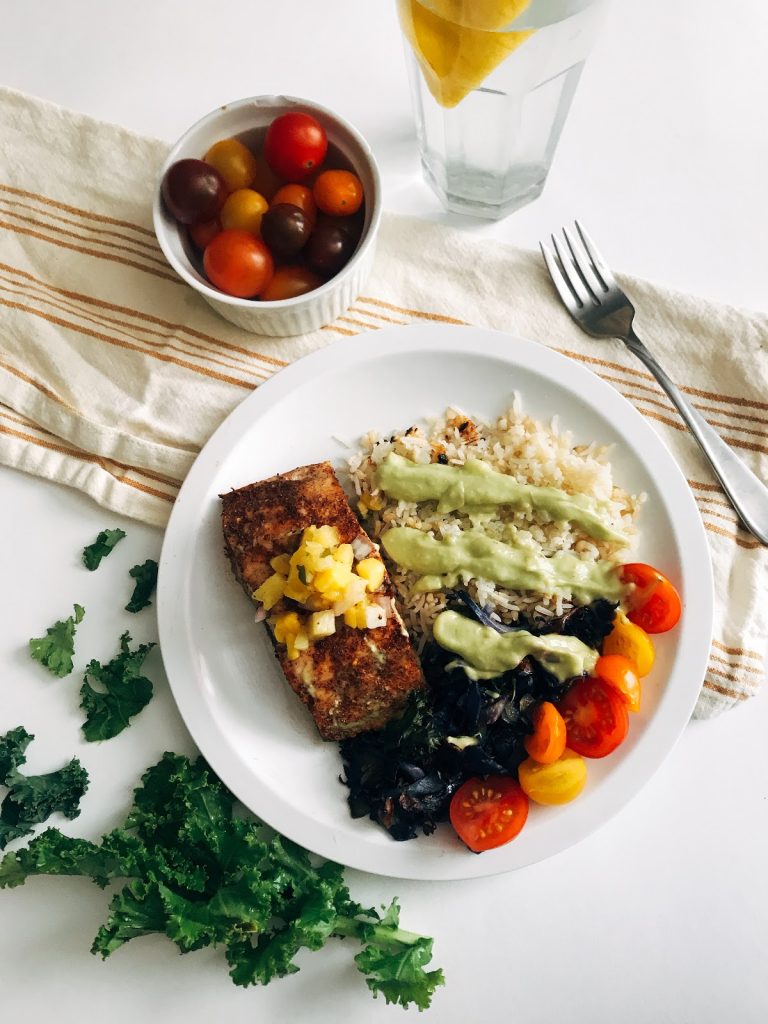
To gluten-free, or gluten-be? That is the question… (that we’re answering!)
As registered dietitian nutritionists, we often get asked from clients about whether or not they should follow a gluten-free diet and if so, how?
This article will help you decide if you should (or should not!) try a gluten-free diet. And if it’s the right route, we provided a list of ingredients & foods to avoid as well as some of gluten-free alternatives.
First of All.. What is Gluten?
Gluten is the general name for the proteins found in wheat, barley, rye, and a wheat/rye blend called triticale.
Gluten helps foods maintain their shape, acting as a glue that holds food together- even some unexpected ones we’ll review below!
To illustrate this point, let’s use the classic example of bread.
Gluten provides texture and structure of bread. It’s a binder that adds a stretchy quality (think of raw pizza dough).
In a gluten free product, other thickening ingredients such as xanthan Gum, guar gum are added in place of the gluten to retain the structure. Without these replacements, the food would just crumble.Let’s start with 3 situations in which going GF is totally warranted:
3 Reasons to go Gluten-Free
- If you are diagnosed with Celiac disease
In people with this autoimmune disease, even just trace amounts gluten triggers the immune system to attack the small intestine, causing a lot of damage. Overtime, the small intestine will lose its ability to absorb vital nutrients, which can lead to severe nutritional deficiencies .
For instance, if the digestive tract cannot absorb iron, a person with celiac may develop iron-deficiency anemia and experience fatigue.
Many people with celiac also experience unwanted side effects such as diarrhea, unwanted weight loss, bloating, constipation, and gas.
Adopting a strict, gluten-free diet is the treatment for celiac.
2. You have a Suspected Gluten Sensitivity
If you are experiencing less severe yet noticeable bloating, discomfort, gassiness, and/or constipation after gluten-containing meals, you may have a sensitivity.
The best way to know? Remove the suspect culprit! It’s not going to hurt you to eliminate gluten for 6 weeks and test it out.
However, adopting a gluten-free diet should not be a replacement for a diagnosis.
3. You Have Dermatitis Herpetiformis
Dermatitis Herpetiformis (DH) is a form of celiac disease, triggering the immune system to attack the skin, rather than the small intestine.
It manifests as a chronic itchy, bumpy, and even painful rash due to a gluten intolerance.
Once diagnosed, following a gluten-free diet can provide relief.
What about Hashiomotos or Thyroid Health?
Hard to say whether a gluten-free diet can be a therapeutic treatment for thyroid conditions. Some small studies (like this one) suggest but cannot proved a benefit of a gluten-free diet to women with autoimmune thyroid disease.
If you do in fact have a gluten sensitivity, it could be causing some inflammation to the gut lining, lessening the absorption of a thyroid medication.

There are also some theories about how a gluten-free diet may also cause a lower inflammatory response and reduce the inflammation of the thyroid gland.
What I tell clients: Reducing gluten can help reduce this inflammation, as can other diet changes. Eliminating gluten entirely for 6-8 weeks is worth a shot and won’t hurt you.
I’ve seen some clients who notice a lot success on a gluten-free protocol but they also have high adherence to a gut healthy, anti-inflammatory diet overall (i.e, little to no sugar, tons of fiber, rich in omega-3).
When following an elimination diet, it’s important to work closely with a registered dietitian to prevent deficiencies and accurately pinpoint trigger foods.
Reasons NOT to Go Gluten-Free
- Weight Loss
A gluten-free alternative doesn’t automatically mean it’s healthier than the original.
This means solely switching from Ritz Crackers to a GF version isn’t going to make a difference if other areas in your diet don’t change.
These other areas? Portions, macronutrient ratio (protein, carbs, and fats), nutrient timing, food quality, etc.
Book an initial consult with one of our dietitians. We can audit your diet or food diary to help you see where you need to make changes to reach a weight loss goal, whether you eat gluten or not.
2. To Be Healthier
Again, gluten-free to equate to healthy (unless you have celiac).
A gluten-free brownie can be loaded with just as much sugar and saturated fat as a traditional, no matter how fancy and pretty the packaging is.
Look at the overall nutrient panel and ingredients in a food before you decide if it belongs in a healthy, balanced diet.
3. Self-Diagnosis
The blood test used to help diagnose celiac disease depends on finding an antibody to gluten in your blood. If you have been avoiding gluten, the antibodies may not show up in your blood test, which could yield a false negative!
Why is this a problem? If you assume what is actually celiac for a mere sensitivity, little ‘slip-ups’ could cause long-lasting damage to your intestine, resulting in subsequent issues such as autoimmune disorders, extreme fatigue, infertility, and even neurological problems.
Individuals with celiac disease should also work closely with a physician to monitor for signs of these problems. So find out first by getting a blood test – then make an informed decision
Gluten-Containing Ingredients
On the ingredients label of a food, scan for the words wheat, barley, and rye.
Less common ingredients to look for include: durum, malt/malt vinegar/malt syrup/malt extract, oats or oat bran, brewer’s yeast, spelt (aka farro), graham flour, bulgur, and hydrolyzed wheat flour.
Gluten is commonly found in products such as…
- Beer, ale, lager
- Breads
- Broth, soup, soup bases
- Cereals
- Cookies and crackers
- Some chocolates, some chocolate bars, licorice
- Flavored coffees and teas
- Imitation bacon bits, imitation seafoods
- Medications (check with your pharmacist)
- Pastas
- Processed foods
- Salad dressings
- Sausages, hot dogs, deli meats
- Sauces, marinades, gravies
- Seasonings
- Soy sauce
If you’re extra sensitive, be sure to opt for grass fed meat and pasture-raised chickens as traditional farming practices feed their livestock grains.
I know- this sounds daunting but the good news is there is a gluten-free alternative to nearly all of these foods (i.e, gluten-free or cauliflower pizza crust, coconut aminos instead of soy sauce, corn tortillas instead of flour…)
And don’t forget about the plethora of naturally GF carbs! Potatoes, squash, rice and rice products, quinoa, corn and corn products, beans, lentils, chickpeas, fruits, veggies, quinoa.. just to name a few!
My Favorite Gluten-Free Brands:
Banza Chickpea Pasta is a alternative that happens to be higher in protein and fiber than traditional OR traditional GF pasta! Win-win. Try it is in the Vegan Thai Pasta Salad.
Kodiak Cakes offers a gluten free high protein pancake/waffle mix and flapjack cup.
KIND has granolas and bars with nuts and puffed grains (brown rice, quinoa, amaranth, and millet) so they’re naturally gluten free.
Other brands I see with a wide variety of products include Simple Mills, Enjoy Life foods, Hippeas, MadeGood, Sweet, Lorens, & Udis.
Find this article helpful? Share it (or the audible version) with a gluten-curious friend or on social media. Be sure to tag us @nutrition.awareness on Instagram!
Kait Richardson is a registered dietitian nutritionist in Orlando, FL. She is a partner at a private practice, Nutrition Awareness, where she helps frustrated yo-yo dieters reach their health goals using 1:1 nutrition coaching. She is the co-host of the Nutrition Awareness Podcast.


